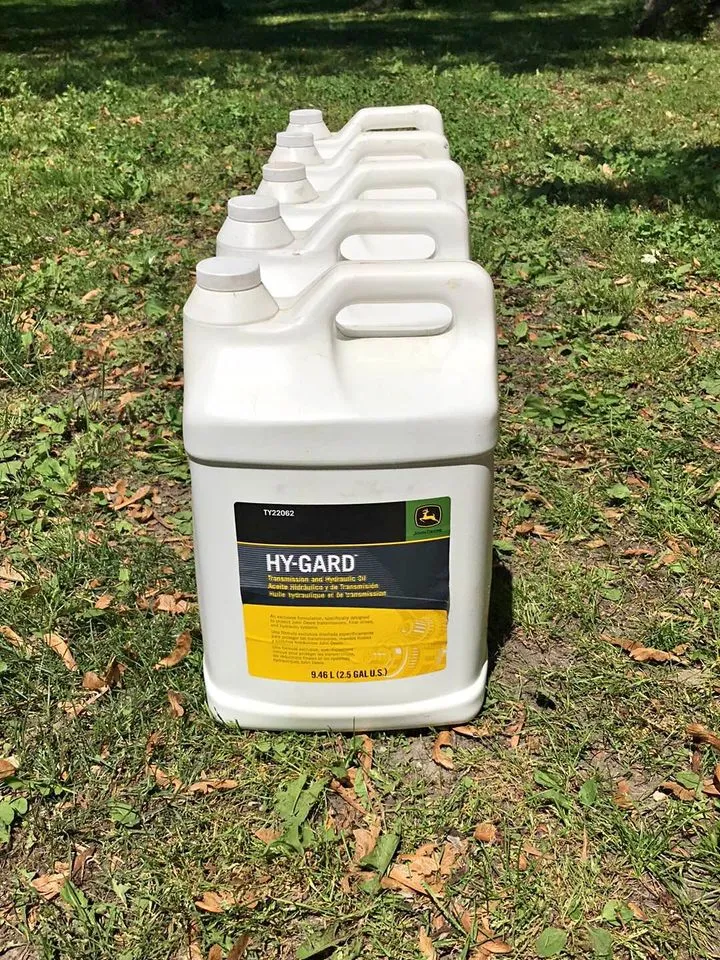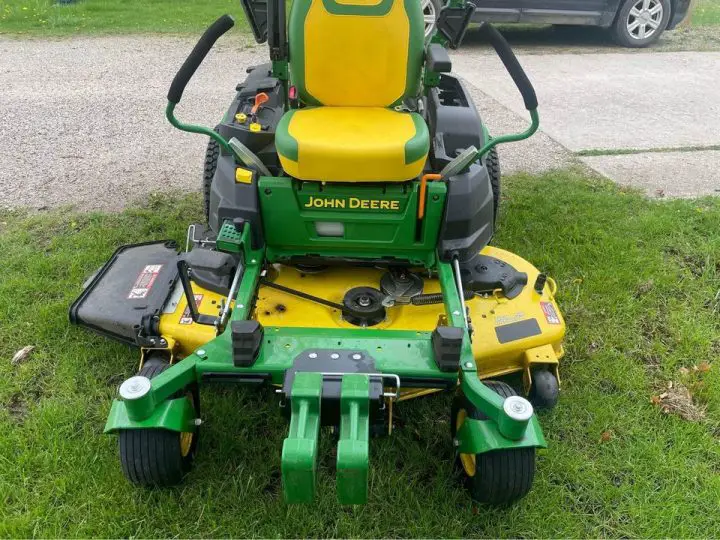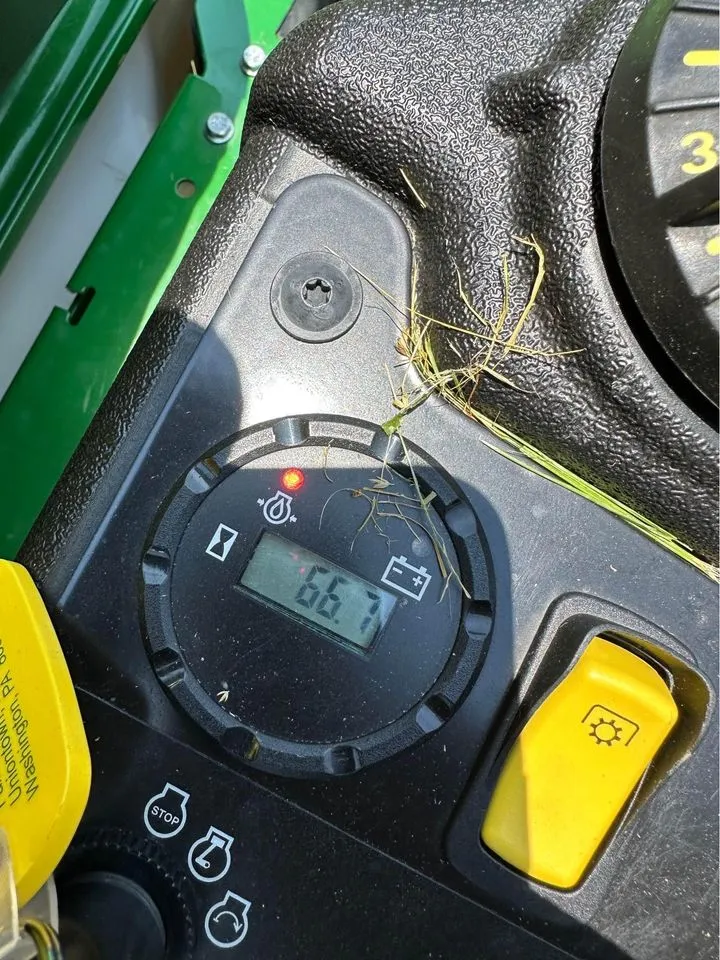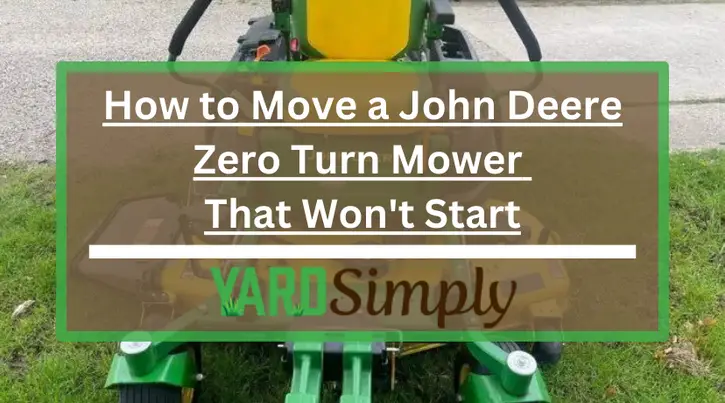When your trusty John Deere zero turn mower refuses to roar to life, it’s like the universe has thrown a wrench in your well-oiled lawn care routine.
I’ve encountered this hiccup more than a few times, and though it’s tempting to let frustration take the wheel, experience has taught me that there’s always a way to navigate these silent standoffs.
The key lies in understanding the mower’s anatomy and the potential culprits behind its stubborn silence. From a misplaced manual transmission bypass lever to a tired, worn-out drive belt, each component could be the piece of the puzzle that’s missing.
But before we get our hands dirty, let’s consider the initial steps to safely maneuver a stationary mower, ensuring we don’t cause more harm than good.
Quick Summary
- To manually move a John Deere zero turn mower that won’t start, it’s crucial to engage the manual transmission bypass lever, ensuring the mower is in a state for safe pushing.
- The article emphasizes routine checks and maintenance, including the mower’s drive belt, tensioner pulley, and idler arm spring, to prevent start-up issues.
- About 20% of lawn mower problems are related to ignition failures, highlighting the importance of ignition system checks in mower maintenance.
- From my personal experience, understanding the intricacies of your John Deere mower, such as its hydraulic system and electrical components, is key to efficiently resolving start-up issues and ensuring smooth operation.
Moving a John Deere Zero Turn Mower
To move a John Deere zero turn mower that won’t start, follow these steps:
- Engage the Manual Transmission Bypass Lever:
- First, locate the manual transmission bypass lever on your John Deere zero turn mower. This lever is typically found at the rear of the mower.
- Engage the lever by moving it to the position that allows for manual pushing. This action disconnects the hydraulic drive system, allowing the wheels to turn freely without starting the engine.
- Check the Brake System:
- Ensure that the parking brake is disengaged. This is crucial because if the brake is engaged, the mower will resist being pushed.
- The brake lever or pedal is usually accessible from the mower’s seat. Release it fully to allow the mower to roll freely.
- Inspect the Area:
- Before you start moving the mower, clear any obstacles in your intended path. This could include tools, branches, stones, or other debris that might obstruct movement or cause damage.
- Ensure the path is clear of any significant inclines or declines where control of the mower might be lost.
- Position for Movement:
- If the mower is in a tight spot, you may need to reposition yourself for better leverage.
- Ensure you have a good grip on the mower. Usually, the best place to push from is the rear of the mower where the transmission bypass lever is located.
- If necessary, enlist the help of another person to either guide the mower from the front or assist in pushing from the rear.
- Push the Mower:
- Once everything is set, begin to push the mower to your desired location. Push steadily and with control to avoid any sudden movements.
- If you’re on a slope, be extra cautious. It’s better to push uphill and pull downhill for better control.
- Re-Engage the Transmission:
- After moving the mower to its new location, don’t forget to re-engage the transmission
Related: How to Start a John Deere Zero Turn Mower Effortlessly
Improper Position of Manual Transmission Bypass Lever
I’ve noticed that a John Deere zero turn mower won’t budge if the manual transmission bypass lever isn’t set right. It’s easy to overlook, but this lever’s position is crucial for moving the mower when the engine’s off.
Let’s examine how this can lead to issues with the drive belt and hydraulic system.
Compromised Drive or Pump Belt: Wear, Slack, or Breakage
A compromised drive or pump belt can prevent a zero turn mower from starting. This can be characterized by wear, slack, or breakage. Often, this issue is caused by the manual transmission bypass lever being in the improper position.
Regular belt maintenance is key to avoiding this problem. If signs of wear or damage are noticed, it is crucial to perform belt replacement promptly to prevent further complications.
Ensuring proper pulley alignment and belt tensioning is part of the routine drive troubleshooting. If the belt is too loose, it won’t transfer power efficiently. On the other hand, an overly tight belt can cause excessive wear or even snap.
Before attempting to start the mower again, it is always important to check the manual to confirm the correct positioning of levers and belts.
Faulty Tensioner Pulley
While ensuring the drive or pump belt is in good condition is essential, examining the tensioner pulley is critical, as a fault here can misalign the manual transmission bypass lever, leading to starting issues.
If I spot a glitch, I’ll contemplate pulley replacement to prevent future misalignment.
Ensuring proper belt alignment is paramount; a misaligned belt can wreak havoc on the mower’s operation. I also make it a habit to perform a lubrication check to keep the pulley operating smoothly.
Adjusting the pulley tension is another maintenance tip I can’t ignore. It’s not just about tightness; it’s about maintaining the right amount of tension for optimal performance.
Degradation or Absence of Idler Arm Spring
Inspecting the idler arm spring is essential, as its deterioration or absence can incorrectly position the manual transmission bypass lever, preventing the mower from starting.
When I perform a mechanical inspection, I always check the spring function to ensure it’s providing the necessary tension for the system. If there’s a problem, I’ll adjust the tension or proceed with arm replacement if the spring is beyond repair.
Regular seasonal maintenance is crucial for catching these issues early. The mower’s ability to engage the drive system is compromised without a proper spring. By keeping an eye on this small but vital component, I can avoid larger issues down the road.
A well-maintained idler arm spring ensures my mower is ready to start and operate when I need it.
Hydraulic Fluid Issues: Low Level or Aged Oil
Checking the hydraulic fluid level and quality is a critical step, as low or aged oil can lead to an improperly positioned manual transmission bypass lever, hindering the start of the mower.
If I’ve neglected this, fluid contamination could be compromising the system. Contaminants wreak havoc, causing hydraulic overheating and potentially leading to seal leaks.
That’s not all; aged oil loses its ideal oil viscosity, thwarting smooth operations.
Moreover, I’ve learned that a low fluid level mightn’t properly engage the bypass lever, which is essential for moving a mower that won’t start.
And let’s not forget about filter blockages; they’re notorious for causing trouble. I’ve got to ensure there’s no debris clogging up the works.
Regular checks and maintenance are non-negotiable to avoid these issues.
Related: How to Change Hydraulic Fluid in Zero Turn Mower
Hydraulic Oil Types and Their Effects on Mower Performance

The type of hydraulic oil used in your John Deere zero turn mower can significantly affect its performance.
For instance, John Deere recommends using its low-viscosity HY-GARD hydraulic/transmission oil to ensure optimal lubrication and prevent overheating and friction in the hydraulic system.
Using incorrect oil types can lead to inefficient lubrication, increased friction, overheating, and potential transmission damage.
Regularly checking and replacing hydraulic oil with the correct type is crucial for maintaining your mower’s health and functionality.
Overheated Hydraulic Fluid
Having addressed the potential problems with low or aged hydraulic fluid, I must also consider the risk of overheated hydraulic fluid, which can stem from the manual transmission bypass lever being out of position.
When the bypass lever isn’t correctly set, the cooling system may not function optimally, leading to a spike in fluid temperature.
This can cause the hydraulic fluid viscosity to change, undermining the mover’s performance and potentially causing damage. It’s crucial to check the temperature gauge regularly and ensure adequate hydraulic venting to prevent overheating.
If I need to tow the mower, I’ll double-check that the bypass lever is correctly positioned to guarantee towing safety and protect the mower’s internals from further heat-related stress.
Presence of Air in the Hydraulic System
When troubleshooting a John Deere zero turn mower that won’t start, one key area to examine is the presence of air in the hydraulic system.
This issue is often linked to an improperly positioned manual transmission bypass lever, leading to air lock in the system which hinders the mower’s movement.
To address this, the hydraulic bleed procedure is essential for purging any trapped air, ensuring the relief valve is correctly adjusted for smooth system operation. It’s also important to check for fluid contamination during this process.
Successfully purging the air from the hydraulic system can restore your mower’s functionality, getting you back to mowing efficiently.
Axle Key Role in Mower Movement
The axle key, a small bar inserted in the axle of your John Deere mower, plays a pivotal role in its mobility. Particularly crucial after tire changes, the key needs to be properly installed for the wheel to move.
If your mower isn’t moving, it’s worth checking if this key has fallen out or is missing, as its absence can immobilize the mower. Regular inspection and maintenance of the axle key are essential for ensuring uninterrupted mower movement.
Troubleshooting Common Issues for Mower Movement

Various issues can prevent a John Deere zero turn mower from moving. The drive release lever, for example, needs to be in the operating position; otherwise, it can impede movement.
The tensioner pulley and idler arm spring also play crucial roles. A worn, loose, or broken drive belt, malfunctioning tensioner pulley, or a missing idler arm spring can all hinder mower movement.
Regular checks and maintenance of these components are essential. If you encounter movement issues, inspect these parts for signs of wear or damage and take appropriate action, such as replacing worn parts.
Steps to Diagnose When Your Key Turn Yields No Response
When I turn the key and my John Deere zero turn mower stays silent, it’s a clear sign something’s amiss.
I’ll start by checking the basics, like the brake and blade control settings, as well as the battery’s health.
If those check out, my next move is to assess the alternator and ensure the starter solenoid is getting power.
Inspect Brake and Blade Control Settings
Ensure the brake is engaged and the control linkage is in the right position for starting, while also verifying that the operator’s presence is correctly sensed.
Additionally, look for any blade obstructions, as these can activate safety protocols that prevent the mower from starting. Understanding your mower’s brake system, whether it’s manual, electronic, or locking, is also crucial.
Each type of brake requires specific steps to disengage for manual movement of the mower when it won’t start.
To effectively troubleshoot a John Deere zero turn mower that won’t start, first inspect the brake and blade control settings, ensuring they are in the correct positions.
This includes verifying brake engagement and checking the control linkage for proper setup. It’s also important to clear any blade obstructions, as these can trigger safety mechanisms preventing startup.
Additionally, familiarize yourself with the type of brakes on your mower, whether manual, electronic, or locking, as this affects how to manually move the mower when it’s not starting.
Evaluate the Battery’s Condition
If turning the key on your John Deere zero turn mower produces no sound or action, it’s time to scrutinize the battery’s health. I grab my multimeter to check the battery voltage; a reading below 12.4 volts indicates it’s time for a charge.
I also look for terminal corrosion, which can disrupt electrical connections and prevent the mower from starting. A bit of baking soda and water cleans the terminals right up if I find any white or greenish buildup.
If the battery’s in dire straits, I’ll follow a jump start procedure. But first, I make sure all connections are tight and secure.
Charge maintenance is crucial for longevity, so I always check the battery’s status after the mowing season and charge it if necessary.
Assess the Alternator’s Functionality
After verifying the battery’s health, I’ll next turn my attention to the alternator, which is pivotal in keeping the mower’s electrical system charged during operation. To diagnose a potential alternator issue, I’ll start by examining the alternator voltage.
A healthy alternator should produce a voltage that’s sufficient to keep the battery charging properly while the engine is running.
Next up, I’ll check the electrical connections to ensure they’re secure and free of corrosion. Any loose or corroded connections could interrupt the charging process.
Additionally, since the alternator is belt-driven, I’ll inspect the belt to make sure it’s tight and intact. A loose or damaged belt can’t turn the alternator at the necessary engine RPMs, resulting in inadequate battery charging and electrical supply.
Verify Power Supply to the Starter Solenoid
To diagnose a silent key turn, I’ll first ensure that the starter solenoid is receiving power by checking the voltage at its connection points.
I’ll start by inspecting the starter connections to see if there’s any visible damage or corrosion that could interrupt the electrical flow.
If everything looks intact, I’ll proceed to the battery terminals, making sure they’re clean and secure for a reliable power source.
Using a multimeter, I’ll perform a voltage check across the solenoid’s input and output terminals. A reading that matches the battery’s voltage would suggest the wiring integrity is sound and power is reaching the solenoid.
If the voltage is low or non-existent, it points to a possible solenoid malfunction or a disconnect somewhere along the circuit.
Ensure Power Reaches the Starter Solenoid Coil
Having confirmed that the starter solenoid is receiving power, I’ll now focus on ensuring this power reaches the solenoid coil to trigger engine cranking. I suspect starter motor issues might be at play if there’s no response when I turn the key.
I’ll start with an electrical connections check. It’s vital to ensure everything’s snug and secure. Loose wires can cause all sorts of headaches. I’m meticulous about cleaning corroded terminals, as they can impede the flow of electricity.
After that, I’ll examine the solenoid mounting bolts. They need to be tight, as a good ground connection is crucial for operation.
Lastly, a battery voltage test will confirm whether the battery is supplying enough juice. If everything checks out, we’re one step closer to solving the puzzle.
Examine the Fuse for Continuity
One often overlooked culprit in a non-starting mower is a blown fuse. I’ll check for continuity to ensure it’s not the issue.
During my fuse inspection, I locate the mower’s fuse box and carefully remove the suspected fuse.
Using a multimeter set to the continuity setting, I perform continuity testing. If the multimeter doesn’t beep or show a reading, it indicates there’s no continuous electrical path – a clear sign the fuse is blown.
Electrical troubleshooting like this is straightforward but critical. With the bad fuse identified through circuit examination, I grab replacement fuses of the correct amperage.
Installing the new fuse is simple, and if that was the problem, my mower should respond the next time I turn the key.
Conduct a Test on the Ignition Switch

If turning the key doesn’t wake the engine, it’s time to scrutinize the ignition switch for potential faults. I start ignition troubleshooting by ensuring my mower’s key maintenance is up to par; worn or damaged keys can fail to engage correctly.
Next, I’ll conduct a spark test to verify whether the engine is receiving the necessary spark to start. This involves inspecting the spark plug connections and testing for a spark.
If the spark test fails, it indicates an issue with the electrical connections or the ignition system itself.
I also perform a starter check. If the starter doesn’t crank, it might be a sign of a deeper electrical problem. I ensure all electrical connections are clean, secure, and undamaged. Addressing these points often gets me closer to pinpointing the issue.
Inspect the Condition of Interlock Switches
After ruling out the ignition switch and starter, I’ll next examine the mower’s interlock switches, which can prevent the engine from starting if they malfunction.
Adhering to safety procedures, I ensure the mower is off and the key removed before I inspect the interlock switches.
These are critical for interlock functionality, designed to ensure the mower doesn’t start unless certain conditions are met, like the operator being seated or the blades disengaged.
I look for signs of connector corrosion or damaged wires, common culprits in electrical troubleshooting. If everything appears intact but the mower still won’t start, I consider switch replacement.
It’s a straightforward fix that can restore the mower to working condition, bypassing the frustration of a non-responsive engine.
Also Read: Why Won’t My Push Mower Start: Troubleshooting Woes
Our Verdict
In my journey with the John Deere zero turn mower, I’ve learned that a mower’s silence can be a call to action, a puzzle that beckons to be solved.
I’ve shared my insights, from the importance of checking the manual transmission bypass lever to the nuances of diagnosing key ignition issues.
My hands-on experience has shown me that the smallest details, like the position of the bypass lever or the state of the hydraulic fluid, make all the difference.
I’ve maneuvered through the quirks of my mower, dealing with drive belt troubles and tackling hydraulic system glitches. This experience has taught me the value of regular maintenance and a keen eye for detail.
For those facing similar silent standoffs with their mowers, remember, it’s not just about fixing a machine; it’s about understanding it, being patient, and learning along the way.
Every mower has its quirks, and with the right approach, you can turn a moment of frustration into an opportunity for learning and growth.
Frequently Asked Questions
Can towing a non-starting John Deere zero turn mower cause any damage to the mower’s transmission or engine?
Towing a mower improperly can risk transmission damage, engine stress, and affect the hydraulic system, potentially leading to costly repair complications. It’s crucial to follow the manufacturer’s guidelines to avoid these risks.
Are there any specific tools or equipment recommended for safely moving a John Deere zero turn mower that won’t start?
I’d recommend using tow straps and hydraulic jacks for lifting, positioning a dolly carefully underneath, and applying winching techniques if needed. Always wear safety gear to prevent injuries during the process.
How can I determine if the issue with my mower not starting is electrical or fuel-related before attempting to move it?
I’ll start troubleshooting by checking the spark, inspecting the battery, testing the starter, and examining the fuel filter to determine if it’s an electrical or fuel-related issue with my mower.
What are the environmental considerations when moving a mower that may have a fuel or oil leak?
I’m considering environmental safety, like leak containment, reducing spill hazards, protecting the soil, ensuring proper fluid disposal, and minimizing wildlife impact when moving equipment that could possibly leak fuel or oil.
Is it possible to push or manually move a John Deere zero turn mower without disengaging the transmission, and what risks does this pose?
I can’t push my mower without a manual override to release the transmission lock; doing so risks wheel damage from undue hydraulic pressure and might cause issues with brake engagement.


